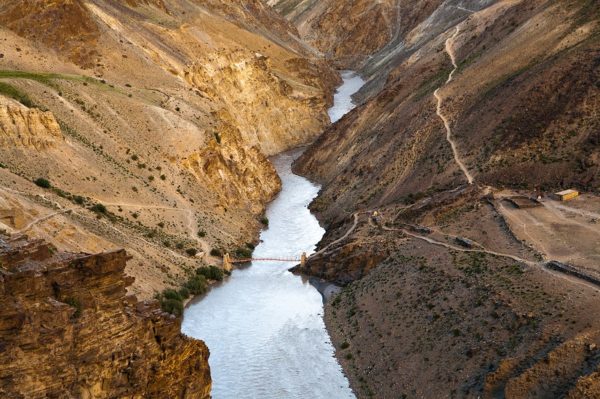It is the “land far, far away” of a fairy tale. Its unknown corners have the call of an adventure. The beauty here changes your definition of beautiful. Its in-your-face isolation has the power to transform.
Zanskar is a valley in the higher Himalayas, about 250 km and an 8-hour drive from Kargil, which is its only connection to the outside world in the summer. In the winter (if they can step out in the cold), a satellite phone connection might be possible.
What’s to see here in the ‘nange parbat’ (barren mountains)?” the driver of the Indian Oil truck we had hitchhiked in, had asked us. He certainly wasn’t the only one wondering. There aren’t many (any) tourists here which means there aren’t too many tourist amenities. Which also means — here’s an entire valley in the heart of the Himalayas waiting to be discovered as you please!
What exactly do you do in such a place?
1. Live all the “deep thoughts” that travel is meant to induce
Get away from it all. Be one with nature. Breathe deeply. Learn to be.
With only the imposing mountains for company without as much as a trace of life on it, these thoughts are easy. Just let the beauty of these mountains leave you awestruck.
Such a long, back-breaking journey, and that is all, we hear you say. Okay, here’s more.
2. Attend a monastery festival that’s not meant for you
These “local events” aren’t targeted towards the tourists — there aren’t many, remember? The decked up monastery, monks dressed in colourful elaborate costumes dancing to trancelike music — these festivals are an extravaganza.
But beyond the obvious entertainment, they are also an occasion for people from across the valley to get together. They are a big part of the social calendar here. These festivals are a perfect opportunity to observe the social camaraderie of the people of Zanskar.
Religion and prayer are their way of life. Prayer beads and mani wheels are ubiquitous. Living in the midst of such harsh nature, where isolation is the only certainty, it was not really surprising!
3. Go to places marked “end of the road” — and beyond
Not the entire Zanskar valley is serviced by roads. The maps actually say “end of the road”. There’s a whole lot of valley left to be discovered beyond these roads. This means there’s ample opportunity to discover Zanskar on foot!
Go on self guided treks. If it’s not safe to go off on your own, your host family will tell you so. Take a local guide with you. They’ll be happy showing off the places they know like the back of their hand.
Many of these trails lead to monasteries, like the Phuktal monastery, set in a cave. Or the Bardan monastery — you don’t realise where the rock ends and the monastery begins!
Just one thing to be kept in mind here. Double the time that the locals — the mountain people for whom these high altitude narrow Himalayan trails are their backyard — say the trail takes.
4. Have lunch with the monks
If you reach a monastery at lunch time, it will be assumed that you are joining the lamas in their mid-day meal. All you have to do is find a place for yourself to be seated. Someone will get a bowl for you. You will be a part of their food service. Simple.
The lunchtime view won’t be too shabby either!
5. Discover the simplicity of local life
Padum is the headquarters of the Zanskar valley. Which is the only place which has a resemblance to life as we know it. It has a few guest houses, restaurants and shops. Beyond Padum, there is a striking dearth of any tourist facilities.
Which means you have to stay with the locals in their homes. Use their dry compost toilets (this was our biggest challenge in Zanskar!). Eat the food they eat, grown in their farms. Drink what they brew at home. This drink is usually the cha or its distilled version, the arhak.
Weddings, get-togethers, even daily dinners — the cha is present. From the young to the old (including women), everyone enjoys their cups of cha. If you refuse to have any, you will be shamed! On long journeys to make sure the kids stay quiet, a few sips of cha come handy. In fact, one of the homestays we stayed at, the guy was a little skeptical about taking us in. It was their arhak distilling day and he didn’t want any other distractions!
Everything moves at a slow pace. Everyone has time for conversations. Over dinner, we would exchange stories with the family we were staying with. The mom would chaff about getting their daughter with us to Mumbai and finding her a suitable boy! We asked if she knew where Mumbai was. “Oh yes, it’s very far.” Mumbai, Delhi or any other country for that matter — they all fell in the “very far” bracket.
We asked them what they did in the winter, with snow everywhere. No electricity, no agricultural activity, how did they spend the time? She explained they lit the woodfire in the room under and everyone sat together in the room above. “But what do you do?” “We all sit together.” “Doing what?” “Sitting by the warmth.” After several exchanges of doing what and sitting, we realised that staying warm was what they did in the winters. “Doing nothing” wasn’t a fancy lifestyle term for them, it was their way of life.
6. Understand what remote actually means
A signboard by BRO (Border Roads Organisation) stands outside the only fuel station in the Zanskar valley. A single hand cranked fuel dispenser is operated by a lone employee there. It poignantly reads, “BRO brings people of the remote to mainstream”.
The biggest lesson was seeing the kids play happily by the village stupa. They sure seemed to have cracked the secret of being happy in the middle of absolutely nowhere!
A visit to the Zanskar valley is an eye opener. A life so simple yet so happy, it becomes a life less ordinary!






Leave a reply